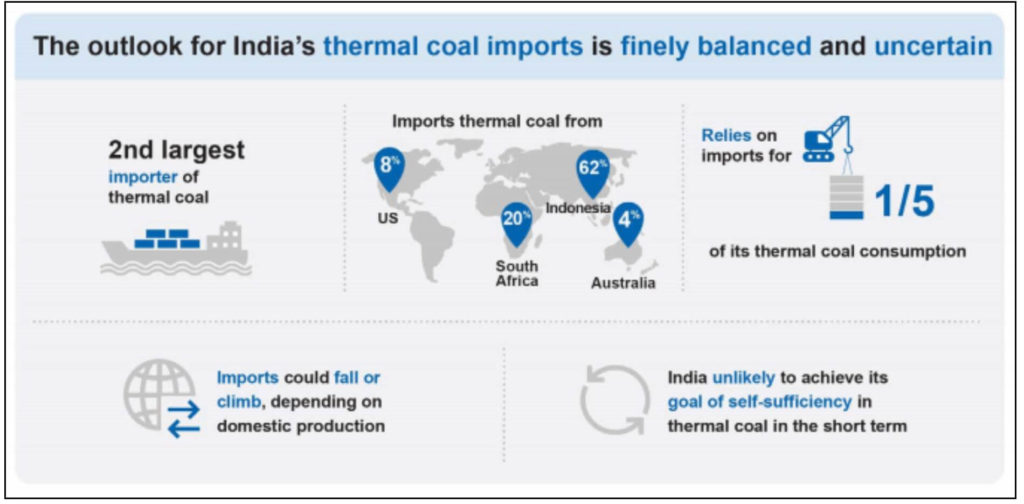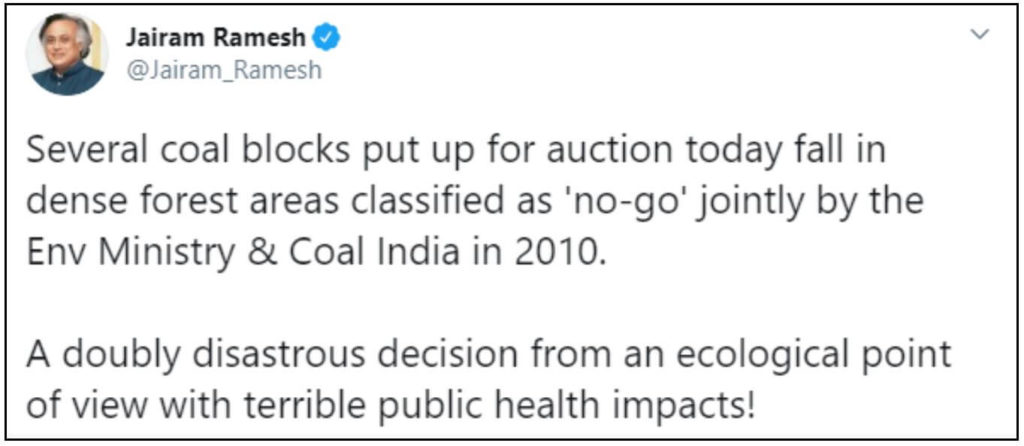The government operationalized the ‘Mineral Laws (Amendment) Act’ by launching the auction of 41 coal blocks in five states. What is new with this auction and what are the different issues involved?
The human race witnessed a major turning point in the 18th century with the industrial revolution transforming economies. It was during this period that the demand for coal soared following the invention of steam engine by James Watt, which made transportation of this fuel easier. Since then, many uses for coal were discovered. In India, coal continues to fuel more than 50% of the power supply in the country for addition to its domestic and industrial purposes. Although India has the fifth largest coal and lignite reserve in the world, the country is the second largest importer of thermal coal.

Source: Coal in India, 2019. Department of Industry, Government of Australia
Reforms in coal sector announced in tranche four of ‘Atmanirbhar Abhiyan’
The government plans to push the idea of self-reliant India through the Atmanirbhar Abhiyan to face and overcome the challenges due to COVID-19. As a part of the package, during the announcement of fourth tranche of the economic package, major reforms have been proposed in the coal sector as well. Broadly, the reforms announced are introduction of ‘commercial mining’ in coal sector, creation of diversified opportunities and a liberalized regime in the sector.

Source: Atmanirbhar Bharat Abhiyan, Government of India
State’s monopoly over coal mining has been replaced by commercial mining
Through the introduction of commercial mining, the government will be ending its monopoly on coal mining and wishes to bring in competition and transparency. The private sector will be allowed to participate coal mining through a revenue sharing mechanism in the place of ‘fixed rupee per tonne’ regime. Now, anyone can take part in auctions for coal blocks including partially explored ones, in contrast to the earlier norm which allowed only captive consumers with end use ownership to participate.
Further, it was also announced that coal gasification/ liquefication will be incentivized through rebate in revenue share. Coal gasification or liquefaction refers to the process by which solid coal is converted into fuel gas or liquid fuel. This move will result in significantly lower environment impact while also assisting India to switch to a gas-based economy, according to the Finance Minister. Rs. 50,000 crores has been pledged by the government to develop the infrastructure in coal sector. Coal Bed Methane rights will also be auctioned from Coal India Limited’s (CIL) coal mines.
41 coal blocks in Eastern and Central India have been opened for auction
On 18 June 2020, Prime Minister Narendra Modi launched the auction of 41 coal blocks for commercial mining spread out in Eastern and Central India in the states of Maharashtra, Odisha, Jharkhand, Chhattisgarh, and Madhya Pradesh. This means that 41 coal mines are now open for private companies, even those which do not have previous experience in coal mining, to mine coal commercially without any end-use restrictions. The only requirement is that the companies must make an upfront payment.

Source: Government of India
The government is expecting a capital investment of around Rs. 33, 000 crores in the next 5 to 7 years. 100% FDI is also permitted in the sector implying that even international companies can participate in the auctions. The producer is free to sell, use, or export coal without any restriction.
PM Modi emphasized on benefits of allowing private firms in his speech
PM Modi repeatedly stressed on the following three major benefits during the launch of the auction of the 41 mines.
- This move will help reduce India’s reliance on imports and also save foreign currency on imports.
- The development of coal sector can also generate lakhs of employment opportunities. It is expected to generate around 2.8 Lakh employment , for the youth, especially in eastern and central India without having to migrate to cities.
- State government will get more revenue which can be used for developmental activities.
Nationalisation of coal mines took place in 1973
During his speech, the PM added that India’s coal sector was being unlocked from decades of ‘lockdown.’ Until 1970s, private sector participation was permitted in coal mining in India. But growing needs in the steel industry and burgeoning energy needs of the country resulted in employment of unscientific mining techniques, exploitation of coal reserves, and poor working conditions of labour. This forced the then government led by Indira Gandhi, to nationalize coal mines. It was done is two phases- first with the coking coal mines in 1971-72 and then with the non-coking coal mines in 1973. After more than four decades, the sector is now open again to private sector without any restrictions.
SC asked for policy reform in coal sector to ensure transparency, after declaring all allocations as illegal
During the period from 1993 to 2011, Ministry of Coal, had allocated 218 coal blocks under the provisions of Coal Mines (Nationalization) Act, 1973 to the erstwhile eligible government PSUs, private companies for specified end use projects such as power, steel, and cement and for commercial mining by PSUs. This was challenged in the Supreme Court, Manohar Lal Sharma Vs. Principal Secretary & Others on allocation of coal blocks, 25/08/2014, saying the allocation of these blocks is illegal & unconstitutional. The Supreme Court declared all the allocations as arbitrary and illegal. Allocations of around 204 coal blocks were cancelled when the Manmohan Singh led UPA’s second term was about to end.
Later in 2015, the NDA government enacted the Coal Mines (Special provisions) Act of 2015 to reallocate the cancelled coal blocks to new allottees through auction or to a government company. Nevertheless, end-use restrictions were in place which meant that these companies could use the product only for select purposes such as cement, iron and steel production, etc. and not for trade. The restrictions were later relaxed in 2018. In March 2020, the government passed the Mineral Laws (Amendment) Act with the aim to promote ease of doing business by removing the restrictions and other measures, as proposed in the Atmanirbhar package.
However, the central government’s decision to privatize coal sector has attracted criticism, particularly from environmentalists since coal mining comes with both social and environmental concerns. The decision is being questioned because there is a global shift towards cleaner fuels.
Coal mining has serious social and environmental implications
Mining activities result in air, water, and noise pollution along with land degradation. This can impact the already vulnerable indigenous populations’ health, culture, and livelihood. Since most of the coal blocks are in forest areas and ecologically sensitive zones, destruction of forests will lead to irreplaceable loss of flora and wildlife. This will only accelerate global warming and climate change. Measures need to be taken by the government to ensure that the green cover and ecological balance are restored. A CAG 2019 report on environmental impact due to mining activities of Coal India Limited reveals that many environmental norms are being flouted.
Congress criticizes, but it overruled the ‘No Go’ condition in 2011
Former environment minister & Congress leader Jairam Ramesh has written a letter to the current environment minister, Prakash Javadekar highlighting the environmental problems due to opening up coal blocks in dense forests. He has referred to it as ‘triple disaster’- environmental cost of mining and transportation of coal in dense forests, loss of carbon sink and dense forest cover which cannot be compensated, and effect on public health.
In 2009-10, Ministry of Environment & Forests headed by Jairam Ramesh classified coal blocks into ‘go’ and ‘no-go’ areas in the five states, based on the forest cover. ‘No-go’ areas are those where the biodiversity is rich and should not be considered for mining. Out of 602 blocks in total, 153 were classified as ’no-go’. About 30% of the blocks fell in the ‘no-go’ area. Ramesh further tweeted that several blocks opened for auction fell in the ‘no-go’ category.

However, in 2011, Ramesh himself overruled the recommendations of the expert forest advisory committee not to give approval for coal mining in three blocks in the dense forest area in Hasdeo Arand in Chhattisgarh, which fell in the ‘no-go’ category. He has also been reported to have said that the blocks were clearly only on the fringe and not within the biodiversity region.
It is ironic that political parties criticise the government actions when they are in opposition but do the same very things when in power. Environment seems to the ultimate loser in this political blame game.
Featured Image: Government auctions 41 Coal Blocks


